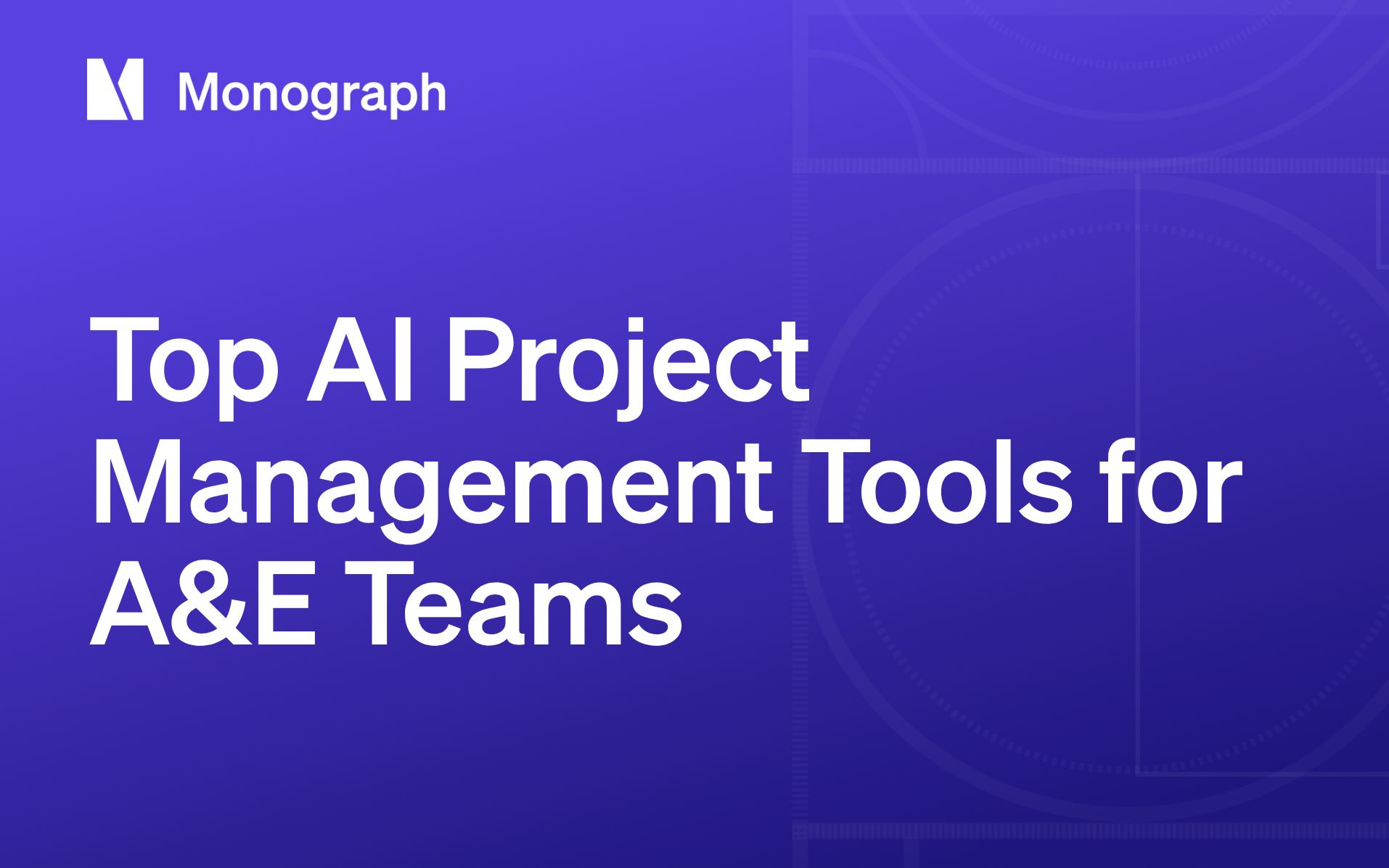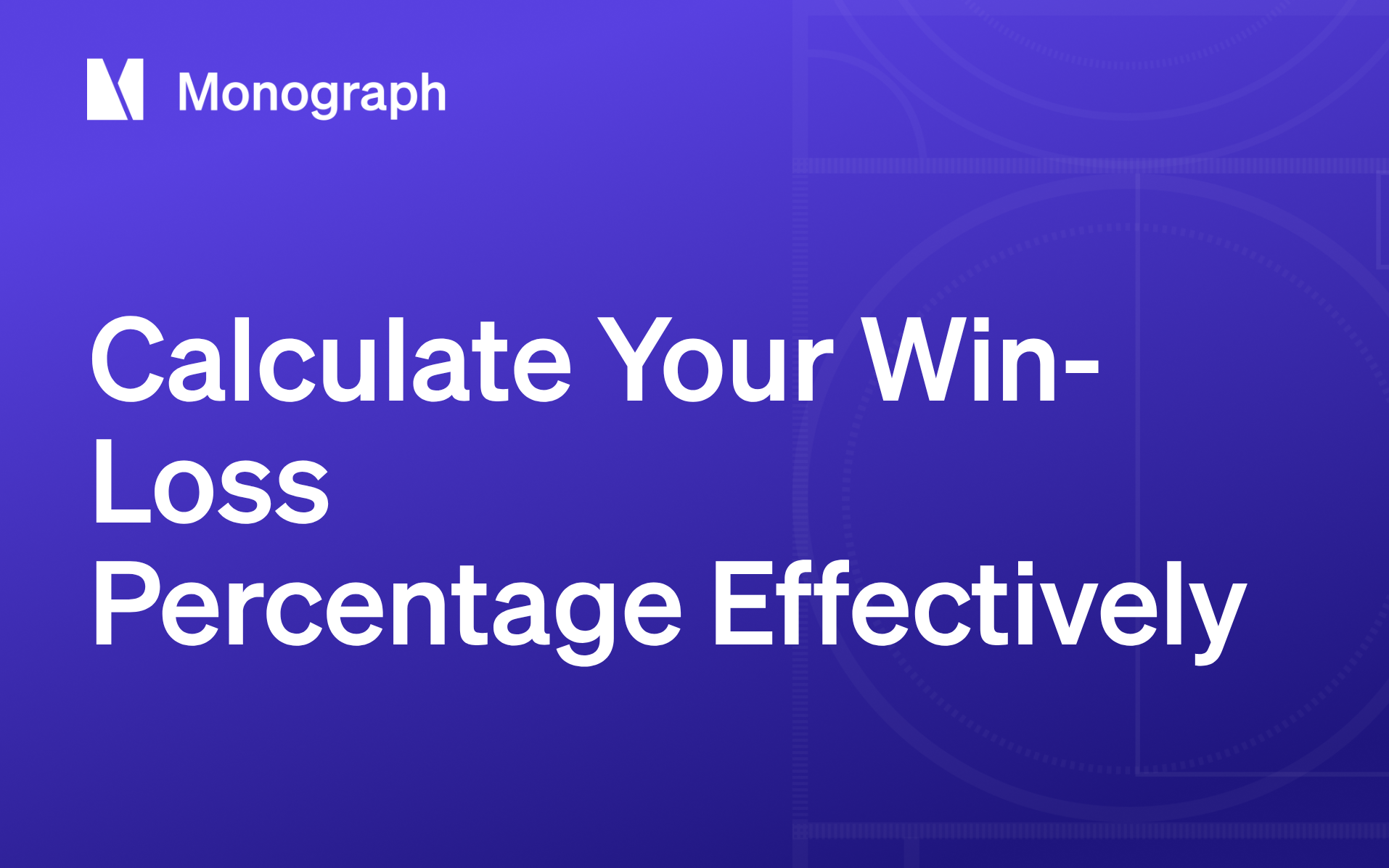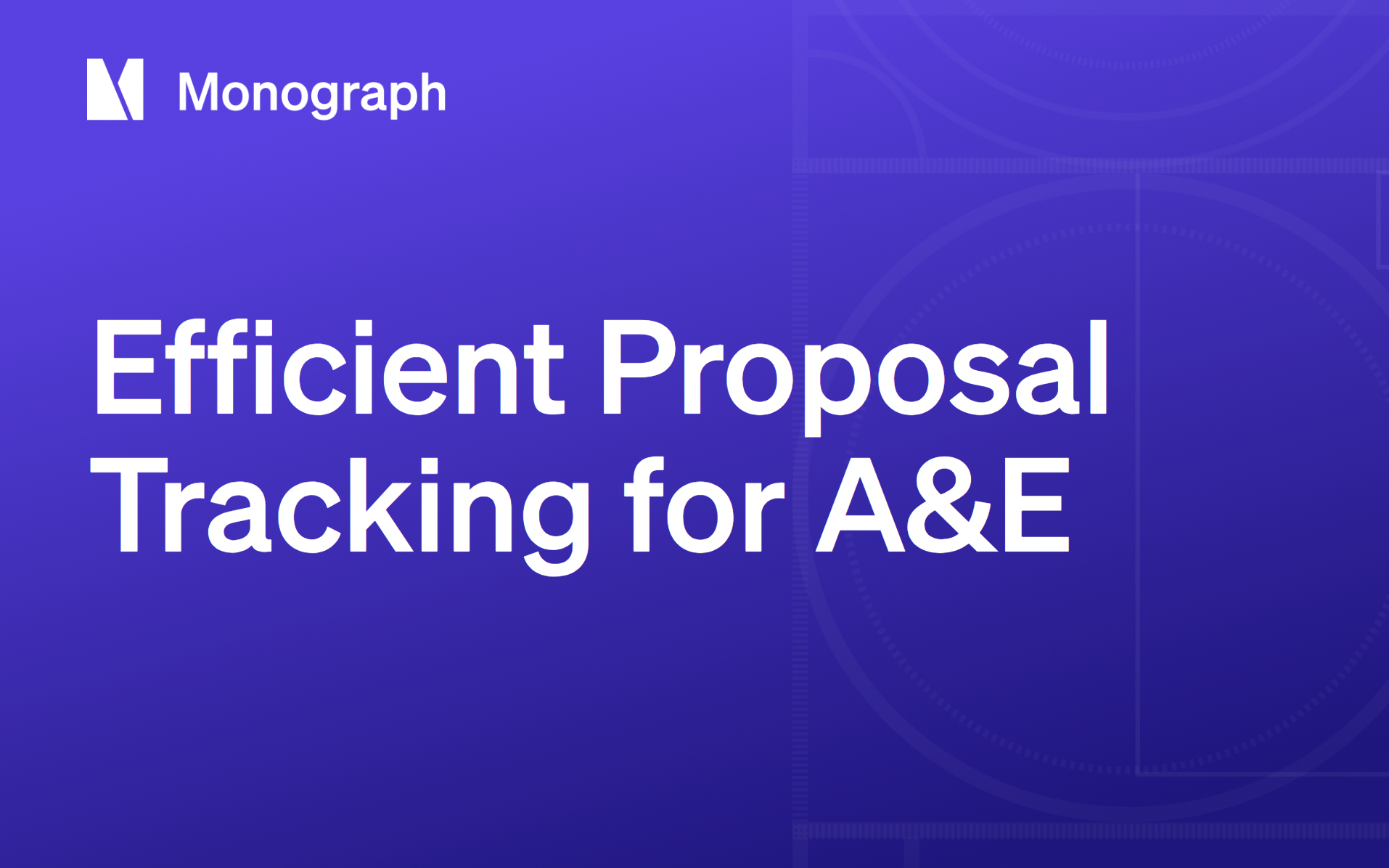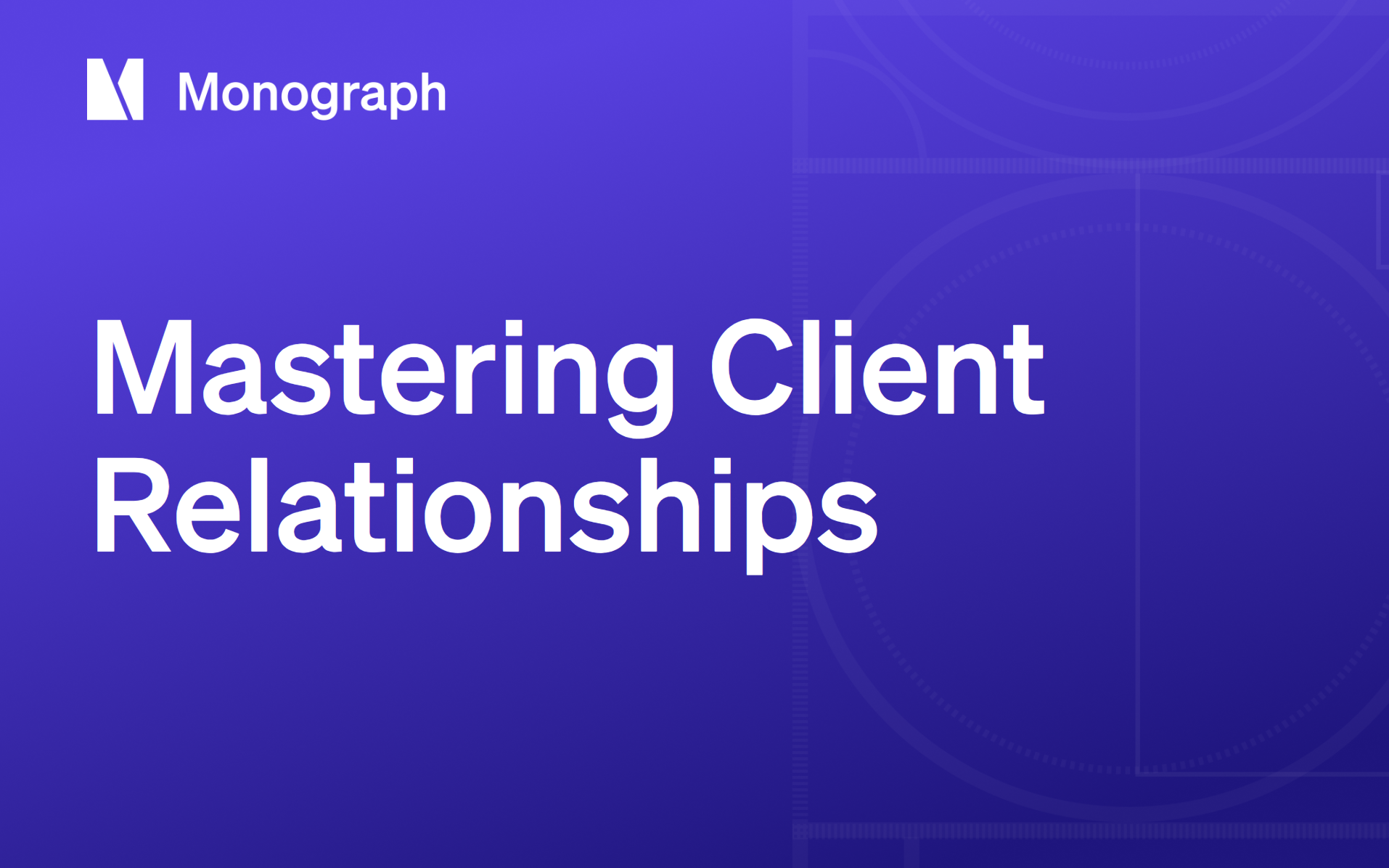Contents
Picture a Monday morning where every project update lives in a different spreadsheet, half the team is tracking hours in email threads, and your phone won't stop buzzing with "quick questions."
We’ve lived that chaos. It's why we dug into the latest wave of AI-powered tools built for architecture and engineering firms. Drawing from sources like Zapier's 2025 roundup and industry reviews, five prominent AI project management tools for architecture and engineering firms are frequently cited: Wrike, Motion, Asana, ClickUp, and Monograph.
We evaluated each platform against four metrics that matter when you're juggling drawings, consultants, and budgets. AI capabilities reveal whether the tool actually does the thinking for you, or just adds another dashboard. Fit with A&E workflows shows if it can handle phase-based billing, BIM files, and consultant coordination without cobbled-together workarounds.
Choose the right partner and you'll spend less time policing spreadsheets and more time designing buildings that make you proud.
Best AI Tools at a Glance
Before you dive into demos, it helps to see each option on one page. Scan the grid, match the "best for" column to your biggest headache, and you'll know exactly where to start.
Even a quick glance makes the differences clear, so pick the column that fixes your firm's biggest pain today and book a test drive.
Monograph: Best for Architecture & Engineering Financial Clarity
If you've ever wrestled with three different spreadsheets just to answer a simple question "Are we still on budget?" you'll feel right at home inside Monograph. Built by architects and engineers who lived that pain, the platform transforms project finance from a guessing game into a live dashboard you can trust.
Start by dragging a signed contract into the system. Monograph's AI parses the document in seconds, auto-building the project budget, schedule, and phase breakdown. No more copy-pasting fee tables or hunting for deadlines buried in PDFs. The essentials appear instantly, already mapped to your firm's phases and deliverables.
From there, Monograph's signature MoneyGantt™ view takes over. Think of it as a traditional Gantt chart with a cash-flow overlay showing every dollar moving from "planned" to "logged," "invoiced," and finally "paid." You see red flags before they become emergencies. Scope creep, fee burn, or delayed payments stand out like a misaligned column in a structural model. Because time entries sync in real time, the chart updates itself while your team works.
Key features that set Monograph apart for A&E firms include:
- Purpose-built for A&E fixed-fee projects, not generic professional services
- Real-time profitability forecasts you can check between design reviews
- Free consultant accounts keep external partners in the loop without extra licenses
Integrated timesheets, invoice generation, QuickBooks Online sync, and Stripe payments close the loop. Hours roll into invoices automatically, clients pay online, and your books reconcile without late-night number crunching. Across 1,800+ firms and 13,000+ users, practices report cutting billing time in half and achieving an average 21% revenue lift simply by catching problems earlier.
Cons:
- Quote-based pricing can feel opaque to small studios budgeting to the penny
- No built-in CAD or BIM markup capabilities, design feedback still lives elsewhere
Pricing follows a tiered, quote-based model. Schedule a demo to discuss options for your firm size.
Motion: Best for Automated Scheduling
Coordinating site visits, design reviews, and client meetings across multiple projects destroys productivity. Motion solves this by treating your calendar as the management system itself, using AI to automatically slot every task, meeting, and deadline into available time, then reshuffling when priorities shift or that structural site inspection runs over.
You set project goals and time estimates. Motion builds the daily plan. When scope changes hit, and they always do, the system pushes non-critical items to tomorrow and alerts the team. No more manual calendar juggling or constant rescheduling battles.
Team-wide visibility means architects and engineers see exactly where commitments land each day. Need your mechanical and structural leads on the same coordination call across three time zones? Motion factors everyone's local hours and working preferences before booking. Fewer "does this time work?" email chains, more actual design progress.
Key Motion advantages include:
- Automated daily planning and re-planning keep projects moving when surprises hit
- One-click focus mode protects design time without extra configuration
- Team-wide visibility eliminates coordination friction across offices and consultants
The focus mode locks you into the next task with one keystroke, hiding distractions and starting a countdown timer. Deep design thinking gets protected time blocks without manual setup. When unexpected client requests threaten your timeline, Motion automatically adjusts and flags the changes for everyone involved.
Cons:
- No budget or cost tracking requires separate financial management
- Team members who rely on spreadsheets face a learning curve trusting the calendar as primary workflow
Motion offers straightforward SaaS pricing with plans such as 'Personal,' 'Team,' and 'Business,' scaling by user count and administrative controls. You pay for automated scheduling that adapts the moment project reality changes.
Asana: Best for Cross-Team Productivity Insights
If your studio juggles multiple projects and disciplines at once, Asana's AI layer acts like a silent coordinator who never sleeps. Its Work Graph™ analyzes every task, deadline, and dependency you enter, then surfaces suggestions: automatic priorities, next-step prompts, or even a first draft of the weekly status you dread writing. Instead of chasing updates, you open Asana and see an AI-generated summary waiting for your review.
The standout feature for A&E teams is workload heatmaps. Asana visualizes assigned hours, allowing managers to see when someone is at capacity or when a structural engineer has room to pick up an extra RFI. That visual cue lets you rebalance resources before burnout or missed deadlines kick in.
Because the platform ties tasks to projects, goals, and portfolios, you can zoom from a single punch-list item to a firm-wide utilization snapshot in seconds. Pair that with 200-plus integrations, including calendars, design tools, and chat apps, and you have a central hub that keeps everyone working from the same drawing set.
Pros:
- Robust templates mirror typical design and construction phases, so project setup takes minutes instead of hours
- AI drafts status updates and meeting notes, cutting report prep time
- Deep integration catalog links Asana to existing modeling, markup, or client communication tools with no double entry
Cons:
- Permission settings can feel like detailing a custom façade; precise, but time-consuming if you rush the setup
- The most powerful AI features live in premium tiers, so smaller firms might start on the free plan and outgrow it quickly
Pricing follows a freemium model with core task management available for free, while advanced AI and portfolio oversight unlock at the Advanced plan and higher. If you need immediate visibility across projects without adding another spreadsheet to your week, Asana's AI insights offer a fast, approachable upgrade.
ClickUp: Best Conversational Assistant for Project Queries
A client calls asking about the latest burn rate, and your budget spreadsheet is buried three folders deep. With ClickUp's AI chat, type "How far over budget is Project 123?" and get the answer instantly. No digging through files or building formulas. This conversational interface sits on top of your existing project data, turning plain questions into real-time intelligence. The result: fewer status meetings and more time for actual design work.
ClickUp pairs that chat capability with customizable dashboards that track A&E metrics including utilization rates, hours by phase, and open RFIs all in one place. Goals tie directly to those dashboards, so when you set a project to stay under 65% fee burn, the system reports progress automatically and alerts you if things drift off course. Since the data comes from shared tasks, documents, and time logs, you don't need to chase anyone for updates.
The advantage is clear: documents, whiteboards, schedules, and budgets live in a single hub, while AI chat eliminates the constant "Can you send me that?" back-and-forth. Conversational interfaces are reshaping daily project questions, freeing up hours each week for billable work instead of administrative tasks.
There are trade-offs worth considering. ClickUp's extensive feature set can overwhelm a small studio that just wants phase tracking and invoicing. The AI assistant requires an add-on purchase, so budget extra if you want those instant answers. Expect about a week of active use before the interface feels natural.
Pricing follows a standard SaaS structure with Free Forever for basic task management, "Unlimited" and "Business" tiers for growing teams, and an "Enterprise" plan for larger practices. The AI functionality is sold separately across all tiers, letting you test the chat features without committing the whole firm to a premium plan.
Wrike: Best for Predictive Risk Alerts
You can't fix a blown budget after the fact. You need to see trouble coming while there's still time to act. That's exactly where Wrike earns its spot on this list. The platform's AI engine watches every task, time entry, and change request, analyzing patterns from your project history to warn you when scope creep is building momentum. If a structural review slips behind schedule or a consultant's hours spike beyond the fee, you'll get a risk alert before the overrun hits your client's inbox.
Wrike backs those warnings with visuals that work for both architects and engineers. Dynamic Gantt charts automatically reshape when dates move, so your schedule reflects what's actually happening instead of what you planned last month. Need to mark up a façade rendering or an InDesign spec sheet? Built-in proofing tools let reviewers comment directly on Adobe files without falling back on email threads.
A single dashboard rolls every project into a portfolio-level heat map that grades risk from "on track" to "critical" in seconds. In busy firms juggling a dozen fixed-fee jobs, that overview helps you spot problems before they become write-offs. The predictive capabilities have been recognized as advanced in project management and are applicable to construction and engineering teams.
Key Wrike advantages for A&E firms include:
- Real-time risk scoring across all active work with predictive alerts
- Robust dashboards your principals can digest quickly during reviews
- Enterprise-grade security that satisfies cautious IT managers
These features combine to create a comprehensive early warning system for project health. The downside? Wrike's interface feels like mission control: powerful but overwhelming until you set up custom views. And the most valuable AI features require the Business tier, so the free Team plan works better for testing than production use.
Pricing follows a standard SaaS structure with a no-cost Free tier for basic task tracking, then paid Team, Business, and Enterprise options where predictive risk alerts, advanced automations, and deeper reporting become available. If your biggest challenge is catching problems before they snowball, the Business tier is where Wrike starts delivering real value.
Other Tools Worth Considering
Sometimes you need targeted help rather than a complete system overhaul. Four general-purpose platforms offer solid AI features that work well for A&E firms when you need specific capabilities rather than comprehensive project management.
Hive's "HiveMind" writing assistant drafts project briefs and meeting agendas automatically, then assigns follow-up tasks. For small studios drowning in client emails and consultant coordination, it's like having an extra set of hands documenting everything without the overhead.
Trello now offers AI assistance within card text fields for summarizing descriptions and crafting text, but does not yet provide fully integrated AI card summaries or next-step prompts directly on Kanban boards. Drop a sketch review or RFI into a card, and Trello distills the conversation into clear status updates plus suggested actions. No more hunting through comment threads to figure out what happens next.
Notion's Q&A assistant transforms project wikis into searchable knowledge bases. Ask "Where's the latest lighting schedule?" and get a direct link to the file. When you're managing spec sheets, zoning notes, and consultant submittals across multiple projects, it handles the mental filing cabinet work.
Zapier connects your favorite tools through automated workflows. For example, you can push updates from Slack into Drive, all automatically. Integration with specialized tools like Revit may require custom solutions or third-party connectors. Fewer manual handoffs mean fewer mistakes and more time for actual design work.
Start Managing Projects Smarter Today
Five platforms solve the problems most A&E firms face every week. Monograph delivers phase-by-phase financial clarity. Motion eliminates scheduling chaos. Asana surfaces productivity insights across disciplines. ClickUp answers project questions instantly. Wrike flags scope creep before it kills profit. Each replaces manual tracking with real-time data, closing the gap between guessing and knowing.
The difference is automation. When calendars, budgets, and risk alerts update themselves, you spend less time managing spreadsheets and more time designing buildings and systems. A&E firms using these platforms report measurable drops in administrative work and cost overruns, which are the kind of improvements that let you focus on the work that matters.
Ready to transform how your firm manages projects? Book a demo to see how Monograph's AI-powered features can streamline your workflow and boost profitability.
Frequently Asked Questions
What makes AI project management tools different from traditional software?
AI project management tools automate routine decisions and surface insights from your data automatically. Instead of manually updating schedules or hunting for budget overruns, AI flags problems, suggests next steps, and even drafts status updates. For A&E firms, this means less time on administrative tasks and more focus on design work.
How do I choose the right AI project management tool for my firm?
Start with your biggest pain point. If financial tracking is your challenge, prioritize tools like Monograph with AI contract parsing and real-time profitability monitoring. For scheduling chaos, consider Motion's automated calendar management. Evaluate based on your firm size, project types, and existing software ecosystem.
Are AI project management tools worth the investment for small A&E firms?
Yes, especially for firms struggling with manual processes. Small practices often see the biggest impact because they eliminate time-consuming administrative work that pulls designers away from billable hours. Many platforms offer freemium tiers that let you test core features before committing to paid plans.
How long does it take to implement AI project management software?
Implementation varies by platform and firm size. Simple tools like Asana or ClickUp can be running in days, while comprehensive platforms like Monograph typically require 2-4 weeks for full setup and team training. Most firms see productivity improvements within the first month of consistent use.





